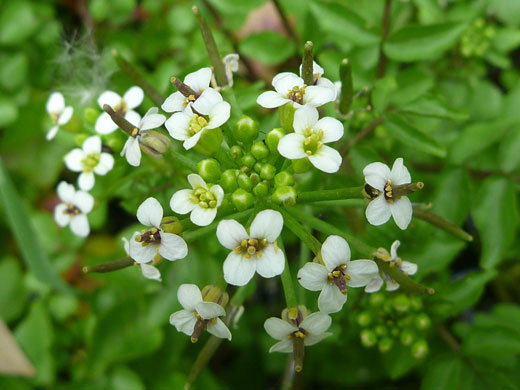
Flower cluster of nasturtium officinale, along the Casner Canyon Trail (near Oak Creek), Sedona, Arizona
Common name:
Watercress
Family:
Scientific name:
Nasturtium officinale
Main flower color:
Range:
All US states (non native)
Height:
Up to 3 feet, generally growing sideways
Habitat:
Streams, marshes, lakeshores, swamp ground
Leaves:
Up to 6 inches long, odd-pinnately divided into 3 to 9 leaflets (occasionally up to 13)
Season:
March to November
Nasturtium officinale has spread from Europe and Asia across most areas of the US, especially west of the Rocky Mountains. The plant grows in or near water; its stems are light and hollow, allowing them to float on the surface of streams and lakes. Leaves are edible, and the plant has a long history of cultivation as a salad vegetable. Stems and leaves are smooth and usually hairless. Leaves are divided into an odd number of non-overlapping leaflets, somewhat variable in shape, often with slightly rippled or toothed edges.
The inflorescence is a densely-packed, spherical cluster, typical of the brassicaceae family; flowers have four unfused, greenish-yellow sepals and four white petals, slightly unequally spaced, with bilateral rather than radial symmetry. The flower center contains six stamens, about the same height as the petals, and a style, which gradually lengthens after pollination to form the slender fruit.
The inflorescence is a densely-packed, spherical cluster, typical of the brassicaceae family; flowers have four unfused, greenish-yellow sepals and four white petals, slightly unequally spaced, with bilateral rather than radial symmetry. The flower center contains six stamens, about the same height as the petals, and a style, which gradually lengthens after pollination to form the slender fruit.
All Contents © Copyright The American Southwest | Comments and Questions | Contribute | Site Map


